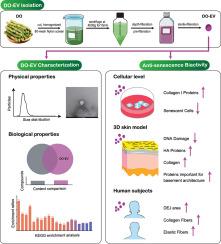Novel exosome-like vesicles from Dendrobium officinale: Unraveling a pioneering extraction protocol and their skin anti-aging potentials
引用次数: 0
Abstract
Objective
Numerous studies suggest that exosome-like nanovesicles (EVs) derived from medicinal plants are crucial for their therapeutic and cosmetic benefits. Nevertheless, the precise role of EVs derived from Dendrobium officinale Kimura et Migo (D. officinale), a treasured traditional Chinese medicine, in promoting skin health has not been extensively studied. Thus, the objective of this study was to establish an effective isolation method to isolate these EVs and to investigate their potential anti-aging benefits for skin.
Methods
We developed a sequential filtration-based isolation process to extract D. officinale EVs (DO-EVs). We compared their physical properties and phytochemical profiles with those of EVs obtained via the standard ultracentrifugation method (UC-EVs) using Nanoparticle Tracking Analysis (NTA), Transmission Electron Microscopy (TEM), and LC-MS/MS. At the cellular level, we assessed the anti-aging efficacy of DO-EVs against UC-EVs and ethanol-extracted polysaccharides from D. officinale (EE-PS) by analyzing pro-COL1A2 levels, cytoskeletal organization, and senescence markers. We further examined DO-EVs’ anti-photodamage effects on UV-treated 3D skin models through histological and immunological staining, and elasticity measurements. Finally, we observed DO-EVs’ impact on human skin using a two-photon microscope.
Results
Both isolation methods yielded EVs of similar size and structure but distinct metabonomic profiles. DO-EVs uniquely contained compounds vital for skin health. Compared to UC-EVs and EE-PS, DO-EVs more effectively enhanced collagen I production, restored cytoskeletal structures, and reduced senescence markers in UV-exposed fibroblasts. In 3D skin models, DO-EVs significantly improved epidermal thickness and skin elasticity post-UV exposure, upregulated hyaluronic acid, collagen I & IV, integrin α6β4, plectin, laminin 5, and nidogen expression, and decreased DNA damage. Human trials confirmed DO-EVs’ effectiveness in enhancing skin structures within two weeks.
Conclusion
Our isolation method successfully extracted D. officinale EVs with superior anti-aging bioactivity compared to UC-EVs or ethanol-extracted polysaccharides. These findings suggest DO-EVs’ great potential as an anti-aging cosmetic ingredient.

铁皮石斛的新型外泌体样囊泡:揭示了一种开创性的提取方案及其皮肤抗衰老潜力
目的:大量研究表明,源自药用植物的外泌体样纳米囊泡(ev)对其治疗和美容功效至关重要。然而,从珍贵的中药木村石斛中提取的ev在促进皮肤健康中的确切作用尚未得到广泛研究。因此,本研究的目的是建立一种有效的分离方法来分离这些ev,并研究它们对皮肤的潜在抗衰老作用。方法建立了一种基于序贯过滤的分离方法,提取officinale ev (do - ev)。我们使用纳米颗粒跟踪分析(NTA)、透射电子显微镜(TEM)和LC-MS/MS将其物理性质和植物化学特征与通过标准超离心方法(uc - ev)获得的ev进行了比较。在细胞水平上,我们通过分析pro-COL1A2水平、细胞骨架组织和衰老标志物,评估了do - ev对uc - ev和乙醇提取的officinale多糖(EE-PS)的抗衰老功效。我们通过组织学和免疫学染色以及弹性测量进一步研究了do - ev对紫外线处理的3D皮肤模型的抗光损伤作用。最后,我们利用双光子显微镜观察了do - ev对人体皮肤的影响。结果两种分离方法获得的ev大小和结构相似,但代谢组学特征不同。do - ev独特地含有对皮肤健康至关重要的化合物。与uc - ev和EE-PS相比,do - ev更有效地促进了uv暴露成纤维细胞的胶原I生成,恢复了细胞骨架结构,并减少了衰老标志物。在3D皮肤模型中,do - ev显著改善了紫外线暴露后的表皮厚度和皮肤弹性,上调了透明质酸、胶原蛋白I和amp;IV,整合素α6β4、粘连素、层粘连蛋白5和氮原的表达,并降低DNA损伤。人体试验在两周内证实了do - ev在改善皮肤结构方面的有效性。结论与uc - ev和乙醇提取多糖相比,我们的分离方法成功地提取了具有较强抗衰老活性的officinale ev。这些发现表明,do - ev作为一种抗衰老化妆品成分具有巨大的潜力。
本文章由计算机程序翻译,如有差异,请以英文原文为准。
求助全文
约1分钟内获得全文
求助全文
来源期刊

Extracellular vesicle
Biochemistry, Genetics and Molecular Biology (General)
自引率
0.00%
发文量
0
审稿时长
43 days
 求助内容:
求助内容: 应助结果提醒方式:
应助结果提醒方式:


